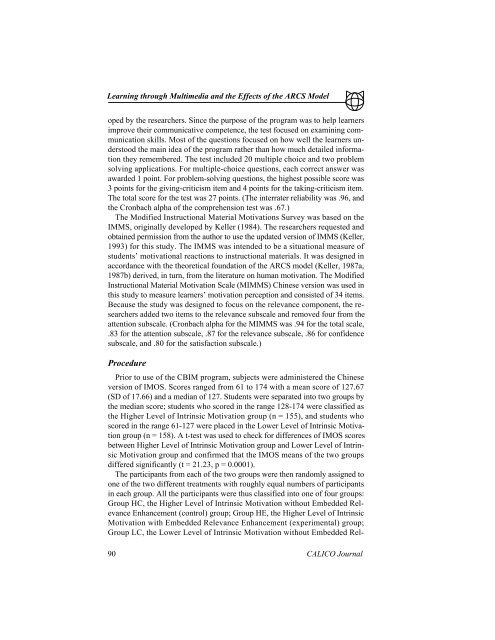Learning Foreign Language through an Interactive Multimedia ...
Learning Foreign Language through an Interactive Multimedia ...
Learning Foreign Language through an Interactive Multimedia ...
You also want an ePaper? Increase the reach of your titles
YUMPU automatically turns print PDFs into web optimized ePapers that Google loves.
<strong>Learning</strong> <strong>through</strong> <strong>Multimedia</strong> <strong>an</strong>d the Effects of the ARCS Model<br />
oped by the researchers. Since the purpose of the program was to help learners<br />
improve their communicative competence, the test focused on examining communication<br />
skills. Most of the questions focused on how well the learners understood<br />
the main idea of the program rather th<strong>an</strong> how much detailed information<br />
they remembered. The test included 20 multiple choice <strong>an</strong>d two problem<br />
solving applications. For multiple-choice questions, each correct <strong>an</strong>swer was<br />
awarded 1 point. For problem-solving questions, the highest possible score was<br />
3 points for the giving-criticism item <strong>an</strong>d 4 points for the taking-criticism item.<br />
The total score for the test was 27 points. (The interrater reliability was .96, <strong>an</strong>d<br />
the Cronbach alpha of the comprehension test was .67.)<br />
The Modified Instructional Material Motivations Survey was based on the<br />
IMMS, originally developed by Keller (1984). The researchers requested <strong>an</strong>d<br />
obtained permission from the author to use the updated version of IMMS (Keller,<br />
1993) for this study. The IMMS was intended to be a situational measure of<br />
students’ motivational reactions to instructional materials. It was designed in<br />
accord<strong>an</strong>ce with the theoretical foundation of the ARCS model (Keller, 1987a,<br />
1987b) derived, in turn, from the literature on hum<strong>an</strong> motivation. The Modified<br />
Instructional Material Motivation Scale (MIMMS) Chinese version was used in<br />
this study to measure learners’ motivation perception <strong>an</strong>d consisted of 34 items.<br />
Because the study was designed to focus on the relev<strong>an</strong>ce component, the researchers<br />
added two items to the relev<strong>an</strong>ce subscale <strong>an</strong>d removed four from the<br />
attention subscale. (Cronbach alpha for the MIMMS was .94 for the total scale,<br />
.83 for the attention subscale, .87 for the relev<strong>an</strong>ce subscale, .86 for confidence<br />
subscale, <strong>an</strong>d .80 for the satisfaction subscale.)<br />
Procedure<br />
Prior to use of the CBIM program, subjects were administered the Chinese<br />
version of IMOS. Scores r<strong>an</strong>ged from 61 to 174 with a me<strong>an</strong> score of 127.67<br />
(SD of 17.66) <strong>an</strong>d a medi<strong>an</strong> of 127. Students were separated into two groups by<br />
the medi<strong>an</strong> score; students who scored in the r<strong>an</strong>ge 128-174 were classified as<br />
the Higher Level of Intrinsic Motivation group (n = 155), <strong>an</strong>d students who<br />
scored in the r<strong>an</strong>ge 61-127 were placed in the Lower Level of Intrinsic Motivation<br />
group (n = 158). A t-test was used to check for differences of IMOS scores<br />
between Higher Level of Intrinsic Motivation group <strong>an</strong>d Lower Level of Intrinsic<br />
Motivation group <strong>an</strong>d confirmed that the IMOS me<strong>an</strong>s of the two groups<br />
differed signific<strong>an</strong>tly (t = 21.23, p = 0.0001).<br />
The particip<strong>an</strong>ts from each of the two groups were then r<strong>an</strong>domly assigned to<br />
one of the two different treatments with roughly equal numbers of particip<strong>an</strong>ts<br />
in each group. All the particip<strong>an</strong>ts were thus classified into one of four groups:<br />
Group HC, the Higher Level of Intrinsic Motivation without Embedded Relev<strong>an</strong>ce<br />
Enh<strong>an</strong>cement (control) group; Group HE, the Higher Level of Intrinsic<br />
Motivation with Embedded Relev<strong>an</strong>ce Enh<strong>an</strong>cement (experimental) group;<br />
Group LC, the Lower Level of Intrinsic Motivation without Embedded Rel-<br />
90 CALICO Journal
















